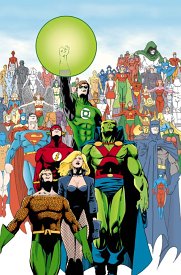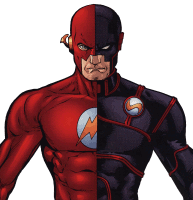Justice League (original) (raw)
 |
Core Members Superman Batman Wonder Woman Flash II/Flash III Green Lanterns Hal Jordan, Kyle Rayner, and John Stewart Aquaman Martian Manhunter* Base of Operations: The Watchtower, on the Moon First Appearance: The Brave and the Bold #28 (March 1960) |
|---|
History
Justice League of America
When six aliens from the world Appelax appeared on Earth to cause destruction, five were defeated by Flash II, Aquaman, Wonder Woman** and/or Black Canary, the Martian Manhunter, and Green Lantern Hal Jordan. The heroes defeated the sixth alien together, and decided to form a permanent team. Taking their cue from the legendary Justice Society, they called their team the Justice League of America.
Originally based in a cave outside Happy Harbor, Rhode Island, the League later moved to a satellite-based headquarters as they collected more members. By the time of the Crisis, the League had grown to nearly two dozen members.
Justice League International
In the wake of a massive campaign by Darkseid’s minion Glorious Godfrey to discredit super-heroes as menaces, the Justice League disbanded. A new League formed, consisting of Batman, Black Canary, Green Lantern Guy Gardner, Blue Beetle, Booster Gold, the Martian Manhunter, Mr. Miracle, Captain Marvel, Dr. Fate, and Dr. Light. Not long afterward, financial tycoon Maxwell Lord convinced the United Nations to sponsor the team, and it became known as Justice League International. Dr. Fate, Dr. Light, and Captain Marvel were replaced with former Global Guardians members Green Flame and Icemaiden (later Fire and Ice) and one of the Russian Rocket Reds.
For the most part the international embassies of the JLI dealt with local heroes and transportation, while the main team remained based in New York. Eventually need was seen for a European branch. Originally headquartered in Paris, later in London, the JLE started with Captain Atom, Power Girl, Metamorpho, Flash III, the Elongated Man, Rocket Red, Wonder Woman and Animal Man. Animal Man and Wonder Woman left early, and the League began to attract local heroes like the Crimson Fox.
While the North American and European branches remained the primary teams, the Martian Manhunter began putting together a task force with rotating membership. This Justice League Task Force would hand-pick heroes for each mission, often bringing in people who weren’t on the League roster.
Zero Hour
All this came crashing down during the Judgment Day of the Overmaster. All Justice League branches worked together to prevent the destruction of the world, but internal strife between Wonder Woman, Captain Atom, and the Martian Manhunter—as well as losing their charter with the UN—led to the formation of three new teams: Wonder Woman’s Justice League of America, the Martian Manhunter’s Task Force, and Captain Atom’s Extreme Justice.
JLA
Two things led to the formation of the next Justice League. First, the enigmatic Know Man boosted the powers of Dr. Destiny to create a world of super-humans. Some of the world’s key heroes, at first believing themselves to be normal and powerless, stopped the pair, believing they were the threat, only to hear Know Man make a cryptic remark that, having defeated his plan, they would have to face a coming menace alone.
Then the Hyperclan arrived. They claimed to be here to help solve the world’s problems, but began a behind-the-scenes campaign to brainwash and enslave the world’s populace. Their plans were uncovered and stopped by seven heroes: Superman, Batman, Wonder Woman, Flash III, Green Lantern Kyle Rayner, Aquaman, and the Martian Manhunter.
These seven heroes formed the new Justice League, building their headquarters (the Watchtower) on the moon. The exact makeup of the team has changed, and when Mageddon—the ultimate destructive force Know Man had warned them about—arrived, their roster included the entire human race.
Elite
 The deep-cover Justice League Elite was an experiment comprised of Vera Black’s Elite (originally a pastiche of Wildstorm’s team, the Authority), past and present League members Flash III, Manitou Raven, and Green Arrow, and a few others. This “black ops” JLE was designed for infiltration and covert operations. (JLA #100, JLA Secret Files 2004, Justice League Elite, 2004—2005)
The deep-cover Justice League Elite was an experiment comprised of Vera Black’s Elite (originally a pastiche of Wildstorm’s team, the Authority), past and present League members Flash III, Manitou Raven, and Green Arrow, and a few others. This “black ops” JLE was designed for infiltration and covert operations. (JLA #100, JLA Secret Files 2004, Justice League Elite, 2004—2005)
Triple Crisis & One Year Later
The murder of Sue Dibny revealed a long-held secret from the satellite era of the Justice League. The League had routinely erased villains’ memories to keep their identities secret. After a vicious attack by Dr. Light, Zatanna attempted to “clean up” his personality. An argument broke out, and in the end they turned on Batman, erasing his memories of the incident (Identity Crisis, 2004).
This revelation brought about new conflict within the League, and served as a rallying cry for the Secret Society of Super-Villains, who ultimately attacked a demoralized Justice League (JLA: Crisis of Conscience, 2005). Tensions flared, made worse by the release of the primal Seven Deadly Sins (Day of Vengeance & Infinite Crisis, 2005–2006), and the team disbanded once again.
The League remained disbanded for a full year after this crisis, and the next incarnation is just forming with the return of Superman, Batman and Wonder Woman.
Text revised September 24, 2006
Do not copy without permission.
- Art Credits
- Profiles in Print
- Series
- Silver-Age Flash Appearances
- Legacy-Era Flash Appearances
- One Year Later Flash Appearances
- Further Notes
 Art
Art
- The Justice League: JLA: Year One #12 (December 1998) - Barry Kitson
- Flash of Two Leagues: JLA Secret Files 2004 (November 2004) - Doug Mahnke and Tom Nguyen
Profiles
- Who’s Who in the DC Universe #12 as the Justice League of America (February 1986)
- The Official Justice League Index (8 issues) (April 1986–March 1987)
- Who’s Who (loose-leaf edition) #7 as Justice League America (February 1991)
- JLA Secret Files #1–3 (1997—)
- Silver Age Secret Files #1 (July 2000)
- JLA–Z #2 (December 2003)
- JLA Secret Files 2004 (November 2004)
- The DC Comics Encyclopedia as the Justice League of America (2004)
- 52 Week 51 (April 25, 2007)
Series
- Justice League of America (1960–1987)
- Justice League / Justice League International / Justice League America (1987–1996)
- Justice League Europe / Justice League International (1989–1994)
- Justice League Task Force (1993–1996)
- Extreme Justice (1994–1996)
- Justice League Quarterly (1990–1993)
- JLA (1996–2006)
- Formerly Known as the Justice League (2003)
- Justice League Elite (2004–2005)
- JLA: Classified (2004—)
- Justice League of America (2006—)
Plus, of course, many mini-series and most big DC crossovers.
Significant Silver-Age Flash Appearances
- Superman #199 (August 1967): “Superman’s Race with the Flash!” Jim Shooter
- Flash #175 (December 1967): “The Race to the End of the Universe,” E. Nelson Bridwell
- Flash #204 (March 1971): “The Great Secret Identity Exposé!” Robert Kanigher
- Flash #276–277 (August–September 1979): “Freakout!” and “The Self-Destruct Flash,” Cary Bates
- Flash #327,329 (November 1983–January 1984): “Burnout!” and “What is the Secret of... Simian & Son,” Cary Bates
Significant Legacy-Era Flash/Impulse Appearances
- Flash Annual 3 (1989): “Flashing on the Past,” William Messner-Loebs (embassies only)
- Flash Annual 3 (1989): “A Chunk at the JLI,” William Messner-Loebs
- Flash #29 (August 1989): “Casablanca Nights,” Len Strazewski (embassies only)
- Flash #61 (April 1992): “The Old Wedding Dodge,” William Messner-Loebs (cameo)
- Green Lantern #30 and Flash #69 (October 1992): “Gorilla Warfare Parts 1–2,” Mark Waid (cameo)
- Flash #100 (April 1995): “Terminal Velocity Overdrive: The Quick and the Dead,” Mark Waid
- Flash #128–129 (August–September 1997): “Hell To Pay Parts 2–3,” Mark Waid and Brian Augustyn
- Flash #136–138 (April–June 1998): “The Human Race,” Grant Morrison and Mark Millar
- Flash #140 (August 1998): “The Black Flash Part 2,” Mark Millar
- Flash #142 (October 1998): “Get Me To The Church On Time,” Mark Waid and Brian Augustyn
- Flash 80-Page Giant #2 (April 1999): “Last Dance,” Christopher Priest
- Flash #159 (April 2000): “Whirlwind Ceremony,” Mark Waid and Brian Augustyn
- Impulse #67 (December 2000): “Friends Like These...” Todd Dezago
- Impulse #86 (July 2002): “Crisis on Impulse’s Earth” Part 1, Todd Dezago
- Flash #209 (June 2004): “Fast Friends,” Geoff Johns
- Flash #214–215 (November–December 2004): “The Secret of Barry Allen” Parts 1–2, Geoff Johns
Significant One-Year-Later Flash Appearances
- The Flash: The Fastest Man Alive #9 (April 2007): “Full Throttle Prologue: Split Decision,” Marc Guggenheim
- Justice League of America #10 (August 2007): “The Lightning Saga: Final Chapter: The Villain is the Hero in His Own Story,” Brad Melzter
- All-Flash #1 (September 2007): “Justice, Like Lightning,” Mark Waid
- Countdown #43 (July 4, 2007): “The Funeral,” Paul Dini with Jimmy Palmiotti & Justin Gray
- Flash #233 (December 2007): “The Wild Wests, Part 3: Fleeting Lives,” Mark Waid
- Flash #235–236 (February–March 2008): “The Wild Wests,” Parts 5–6, Mark Waid
- The Flash #239 (June 2008): “Fast Money Part 2,” Tom Peyer
- Flash #244–247 (November 2008–February 2009): “This Was Your Life, Wally West,” Alan Burnett
Notes
* The Martian Manhunter has been in virtually every incarnation of the Justice League.
** Originally, Wonder Woman was a founding member. When the DCU was revised after Crisis on Infinite Earths (1986), her debut was set after this incarnation of the JLA disbanded. Black Canary took her place in flashbacks. When the DCU was revised again in Infinite Crisis (2006), Wonder Woman and Black Canary were both founding members. (Infinite Crisis and the Justice League origin in 52 #51, 2007)
Additionally, Superman and Batman had much more active roles with the pre-CoIE version of the team.
